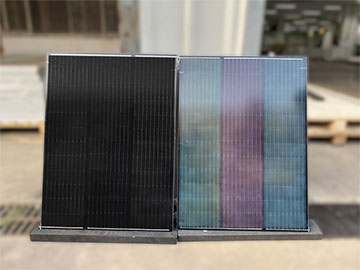
Photonic glasses allow fabrication of colored solar cells without significant loss of efficiency. [Image: Adapted from Z. Li et al., ACS Nano, doi: 10.1021/acsnano.2c05840 (2022)]
As the demand for renewable energy increases, more buildings have integrated photovoltaic cells into their structures in the quest for sustainable design. The traditional black color of solar panels, however, limits their use as a decorative element and makes them unappealing to some consumers. Conceivably, those aesthetic considerations might hold back efforts to make solar cells a viable, popular option for a broader range of construction.
Now researchers in China say they’ve devised a photovoltaic colorization technology that could add a bit of visual flair to solar installations (ACS Nano, doi: 10.1021/acsnano.2c05840). According to the researchers, their technique enables the large-scale, cost-effective fabrication of colored solar panels without a significant loss in power conversion efficiency (PCE).
Seeing color
The function of solar panels is to absorb light, so colored panels, by definition, imply suboptimal light absorption. Organic dyes and inorganic pigments can be added to the surface of black solar cells, but they intrinsically absorb solar radiation and therefore reduce PCE. Previous attempts to circumvent this loss of productivity used multilayer dielectric films, which can selectively reflect visible light and therefore retain efficiency. But the films are expensive and difficult to produce on a large scale, and they can create an undesirable iridescent effect.
The researchers behind the current work used short-range correlated dielectric microspheres, or photonic glass, to address the shortcomings of other colorization methods. They sprayed a thin layer of the photonic glass, composed of colloidal monodisperse zinc sulfide microspheres, onto the surface of the solar cells. Since the microspheres are dielectric and have an isotopic structure, they can selectively reflect visible light based on the size of the spheres—with negligible parasitic absorption of solar radiation, avoiding dissipative losses.
Efficient and durable
The resulting colored solar cells, in hues of blue, green and purple, had a PCE of 21.5%, compared with 22.6% for black solar cells. When the team further tested the cells in photovoltaic modules, or solar panels, using standard encapsulation methods, the colored panels’ PCE came in at 20.9%—close, the researchers say, to the 21.21% PCE of black solar panels. The panels also performed well in aging tests, including in an outdoor exposure test for 10 days and a damp-heat test for 1000 hours, demonstrating their long-term stability.
According to the researchers, their production process does not require any special equipment or environment, so it is less costly than previous methods for colorizing solar cells. They also note that the self-assembled, disordered structure of the photonic glass, which does not have strict periodicity requirements, makes fabrication simple and easily scalable for mass production. In future work, the team plans to explore ways to make the colors more saturated without sacrificing further PCE, as well as to achieve a wider range of colors.
The research included scientists from Shanghai Jiao Tong University, Xinjiang University and The Hong Kong Polytechnic University.
